Vietnam Veterans Memorial
 From Nwe
From Nwe
Vietnam Veterans Memorial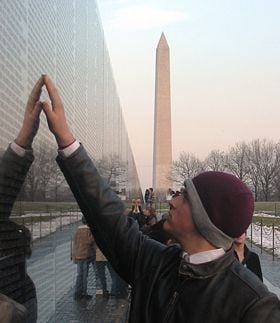
|
|
|---|---|
| IUCN Category V (Protected Landscape/Seascape) | |
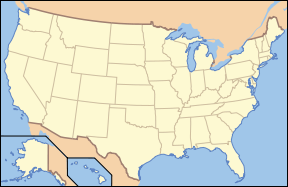
|
|
| Location: | Washington, D.C., United States |
| Area: | 2.00 acres (8,100 m²) |
| Established: | November 13, 1982 |
| Visitation: | 3,799,968 (in 2005) |
| Governing body: | National Park Service |
The Vietnam Veterans Memorial is a national war memorial in Washington, D.C. honoring members of the U.S. armed forces who fought in the Vietnam War and who died in service or are still unaccounted. The memorial was inspired by the 1971 establishment of the Vietnam Veterans Memorial State Park in Angel Fire, New Mexico, which was begun by the grief-stricken parents of Marine First Lieutenant David Westphall, who was among thirteen men in his unit killed in an ambush in Vietnam in 1968.
The main part of the memorial, which was completed in 1982, is located in Constitution Gardens adjacent to the National Mall, just northeast of the Lincoln Memorial. The memorial is maintained by the U.S. National Park Service, and receives around three million visitors each year. It was designed by U.S. architect Maya Lin.
The memorial consists of two low, black granite walls that meet to form a wide V shape. Engraved on the mirror-like surface are the names of the more than 58,000 U.S. dead and missing-in-action who served in the Vietnam War, listed by date of casualty. Initially protests arose around the memorial's non-traditional design, prompting the creation of a statue depicting three servicemen standing at the entrance to the site, overlooking the Wall. This was followed a decade later with a statue memorializing the women who served.
Since its dedication in 1982, the once-controversial Wall has become one of Washington, D.C.'s most visited tourist attractions. In 2007, the memorial was ranked tenth on the "List of America's Favorite Architecture" by the American Institute of Architects.
The Vietnam Conflict was a highly unpopular war, and returning soldiers received little welcome or acknowledgment of their services. While the Memorial honors those who did not return, it also offers an opportunity for healing of the wounds of a turbulent and confusing time in America's history.
Inspiration for the memorial
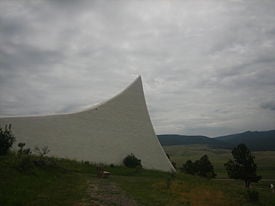
The first major memorial to honor veterans of the Vietnam War was created in the Sangre de Cristo Mountains on the Enchanted Circle of northeastern New Mexico. It is the only state park dedicated exclusively to veterans of the Vietnam War. The memorial was begun by Victor and Jeanne Westphall, the grief-stricken parents of Marine First Lieutenant David Westphall, who was among thirteen young men in his unit killed in an ambush in 1968 in Vietnam. The Westphalls used their son’s insurance policies to begin construction of the Peace and Brotherhood Chapel, which is surrounded by white stone in a pyramid shape. The David Westphall Veterans Foundation has since supported the operation of the memorial, which was opened without charge to the public in 1971. At the time of its construction, the site received national media attention and helped to inspire the establishment of the Vietnam Veterans Memorial in Washington, D.C., completed in 1982. In 1987, the United States Congress recognized Angel Fire as a memorial of national significance. The park hosts thousands of annual visitors, many moved emotionally by the sacrifice of the Vietnam veterans.[1]
History

- April 30, 1975 – The Fall of Saigon.
- April 27, 1979 – The Vietnam Veterans Memorial Fund, Inc. (VVMF), was incorporated as a non-profit organization to establish a memorial to veterans of the Vietnam War. Much of the impetus behind the formation of the fund came from a wounded Vietnam veteran, Jan Scruggs, who was inspired by the film The Deer Hunter. Eventually, $8.4 million was raised by private donations.
- July 1, 1980 – Congress authorizes three acres near the Lincoln Memorial for the site. The "temporary" Munitions Building, built for War Department offices during World War I and finally razed in 1965, formerly occupied the site. The memorial is to be managed by the National Park Service under its National Mall and Memorial Parks group. A design competition is announced.
- December 29, 1980 – 2,573 register for design competition with a prize of $50,000.
- March 31, 1981 – 1,421 designs submitted. The designs are displayed at an airport hangar at Andrews Air Force Base for the selection committee, in rows covering more than 35,000 square feet (3,300 m²) of floor space. Each entry was identified by number only, to preserve the anonymity of their authors. All entries were examined by each juror; the entries were narrowed down to 232, finally 39. The jury selected entry number 1026.
- May 6, 1981 – A jury of eight architects and sculptors (Harry Weese, Richard Hunt, Garret Eckbo, Costantino Nivola, James Rosati, Grady Clay, Hideo Sasaki, Pietro Belluschi, working with architectural advisor Paul Spreiregen)[2] unanimously selected a design by Maya Ying Lin, a 21-year-old Yale University architecture student from Athens, Ohio as the winner from 1,421 entries.
- January 1982 – The Three Soldiers was added to the design as a result of controversy over Lin's design.
- March 11, 1982 – The design is formally approved.
- March 26, 1982 – Ground is formally broken.
- October 13, 1982 – The U.S. Commission of Fine Arts approves erection of a flagpole to be grouped with sculptures.
- November 13, 1982 – Memorial dedication after a march to its site by thousands of Vietnam War veterans. As a National Memorial it was administratively listed on the National Register of Historic Places the same day.
- November 1984 – The Three Soldiers statue is dedicated.
- November 11, 1993 – Vietnam Women's Memorial is dedicated.
- November 10, 2004 – Dedication of memorial plaque honoring veterans who died after the war as a direct result of injuries suffered in Vietnam, but who fall outside Department of Defense guidelines.
Structure
Memorial Wall

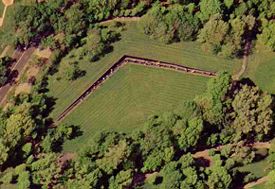
The Memorial Wall, designed by Maya Ying Lin, is made up of two black granite walls 246 feet 9 inches (75 meters) long. The walls are sunk into the ground, with the earth behind them. At the highest tip (the apex where they meet), they are 10.1 feet (3 m) high, and they taper to a height of eight inches (20cm) at their extremities. Granite for the wall came from Bangalore, Karnataka, India and was deliberately chosen because of its reflective quality. Stone cutting and fabrication was done in Barre, Vermont. Stones were then shipped to Memphis, Tennessee where the names were etched. The etching was completed using a photoemulsion and sandblasting process developed at GlassCraft by their research and development division (now known as Glassical, Inc.). The negatives used in the process are in storage at the Smithsonian Institution. When a visitor looks upon the wall, his or her reflection can be seen simultaneously with the engraved names, which is meant to symbolically bring the past and present together. One wall points toward the Washington Monument, the other in the direction of the Lincoln Memorial, meeting at an angle of 125° 12′. Each wall has 72 panels, 70 listing names (numbered 1E through 70E and 70W through 1W) and 2 very small blank panels at the extremities. There is a pathway along the base of the Wall, where visitors may walk, read the names, make a pencil rubbing of a particular name, or pray. Some people leave sentimental items there for their deceased loved ones, and non-perishable items are stored at the Museum and Archaeological Regional Storage Facility, with the exception of miniature American flags.
Inscribed on the walls with the Optima typeface are the names of servicemen who were either confirmed to be KIA (Killed in Action) or remained classified as MIA (Missing in Action) when the walls were constructed in 1982. They are listed in chronological order, starting at the apex on panel 1E in 1959 (although it was later discovered that the first casualties were military advisers who were killed by artillery fire in 1957), moving day by day to the end of the eastern wall at panel 70E, which ends on May 25, 1968, starting again at panel 70W at the end of the western wall which completes the list for May 25, 1968, and returning to the apex at panel 1W in 1975. Symbolically, this is described as a "wound that is closed and healing." Information about rank, unit, and decorations are not given. The wall listed 58,159 names when it was completed in 1993; at the beginning of 2009, there were 58,260 names, including 8 women.[3] Approximately 1,200 of these are listed as missing (MIAs, POWs, and others), denoted with a cross; the confirmed dead are marked with a diamond. If the missing return alive, the cross is circumscribed by a circle; if their death is confirmed, a diamond is superimposed over the cross. According to the Vietnam Veterans Memorial Fund, "there is no definitive answer to exactly how many, but there could be as many as 38 names of personnel who survived, but through clerical errors, were added to the list of fatalities provided by the Department of Defense."[4] Directories are located on nearby podiums so that visitors may locate specific names.
Beginning and ending timeline for those listed on the wall
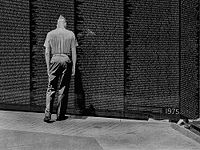
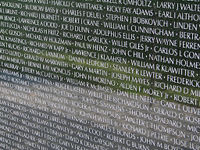
- November 1, 1955 – Dwight D. Eisenhower deploys Military Assistance Advisory Group to train the South Vietnamese military units and secret police. However, the U.S. Department of Defense does not recognize this date since the men were supposedly only training the Vietnamese. The officially recognized date is the formation of the Military Ass istance Command Viet-Nam, better known as MACV. This marks the official beginning of American involvement in the war as recognized by the memorial.
- June 8, 1956 – The first official death of the Vietnam War is U.S. Air Force Technical Sergeant Richard B. Fitzgibbon, Jr. of Stoneham, Massachusetts who was killed by another U.S. airman.
- October 21, 1957 – U.S. Army Special Forces Captain Harry G. Cramer is killed during a training action. He is added to the wall after its dedication.
- July 8, 1959 – Charles Ovnand and Dale R. Buis are killed by guerrillas at Bien Hoa while watching the film The Tattered Dress. They are listed 1 and 2 at the wall's dedication.
- April 30, 1975 – Fall of Saigon. The U.S. Department of Veterans Affairs uses May 7, 1975 as the official end date for the Vietnam era as defined by Title 38 U.S. Code Section 101.
- May 15, 1975 – 18 Marines are killed on the last day of a rescue operation known as the Mayagüez incident with troops from the Khmer Rouge in Cambodia. They are the last servicemen listed on the timeline, and include Daniel A. Benedett, Lynn Blessing, Walter Boyd, Gregory S. Copenhaver, Andres Garcia, Bernard Gause, Jr., Gary L. Hall, Joseph N. Hargrove, James J. Jacques, Ashton N. Loney, Ronald J. Manning, Danny G. Marshall, James R. Maxwell, Richard W. Rivenburgh, Elwood E. Rumbaugh, Antonio Ramos Sandovall, Kelton R. Turner, and Richard Vande Geer.
The Three Soldiers
A short distance away from the wall is another Vietnam memorial, a bronze statue named The Three Soldiers. The grouping consists of three young men, armed and dressed appropriately for the Vietnam War era, purposely identifiable as Caucasian, African American, and Hispanic. It was designed to complement the Vietnam Veterans Memorial, by adding a more traditional component. The statue, unveiled on Veterans Day, 1984, was designed by Frederick Hart, who placed third in the original design competition. The statue and the Wall appear to interact with each other, with the soldiers looking on in solemn tribute at the names of their dead comrades. The distance between the two allows them to interact while minimizing the impact of the addition on Lin's design.
Women's Memorial
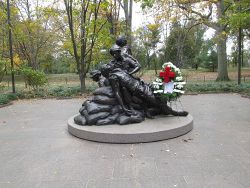
Approximately 11,000 American military women were stationed in Vietnam during the war. It is estimated that the total number of women who served throughout the world in a variety of occupations was 265,000. Close to ninety percent of those in Vietnam were nurses in the Army, Navy, and Air Force. Thousands of women served in Japan, Guam, the Philippines, Hawaii, and other stateside hospitals caring for the wounded and dying who had been stabilized and flown out of the war zone. Some were stationed aboard hospital ships stationed off the coast of South Vietnam. Others served as physicians, physical therapists, personnel in the Medical Service Corps, air traffic controllers, communications specialists, intelligence officers, and clerks. Nearly all of them volunteered. By 1967, nearly all military nurses who volunteered to go to Vietnam did so shortly after graduation, the youngest group of medical personnel ever to serve in war time.[5]
To honor those women, the Vietnam Women's memorial statue was added to the memorial site eleven years after the erection of the main memorial. It is located a short distance south of the Wall, north of the Reflecting Pool. It depicts three uniformed women with a wounded soldier. The woman looking up is named Hope, the woman praying is named Faith, and the woman tending to a wounded soldier is named Charity. The memorial was designed by Glenna Goodacre and dedicated on November 11, 1993.
In Memory memorial plaque
A memorial plaque was dedicated on November 10, 2004, at the northeast corner of the plaza surrounding the Three Soldiers statue to honor veterans who died after the war as a direct result of injuries suffered in Vietnam, but who fall outside Department of Defense guidelines. The plaque is a carved block of black granite, 3 feet (0.91 m) by 2 feet (0.61 m), inscribed "In memory of the men and women who served in the Vietnam War and later died as a result of their service. We honor and remember their sacrifice."
Ruth Coder Fitzgerald, founder of The Vietnam War In Memory Memorial Plaque Project, worked for years and struggled against opposition to have the In Memory Memorial Plaque completed.[6]
Controversies
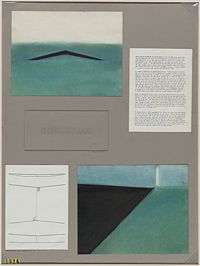
The Vietnam War was one of the longest and most controversial wars in United States history. A stated goal of the memorial fund was to avoid commentary on the war itself, serving solely as a memorial to those who served. Nevertheless, a large number of controversies have surrounded the memorial.
Maya Lin
As depicted in a documentary about Maya Lin (Maya Lin: A Strong Clear Vision), reactions to the chosen memorial design were intensely mixed. At the time of the contest, Lin was a young student at Yale University. The wall was designed as a class project for a funerary design class.
Women's memorial
The original winning entry of the Women's Memorial design contest was deemed unsuitable. Glenda Goodacre's entry received an honorable mention in the contest and she was asked to submit a modified design model. Goodacre's original design for the Women's Memorial statue included a standing figure of a nurse holding a Vietnamese baby, which although not intended as such, was deemed a political statement, and it was asked that this be removed. She replaced them with a figure of a kneeling woman holding an empty helmet.
The Moving Wall
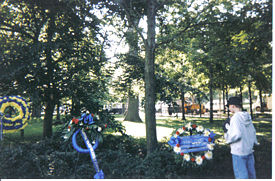
Vietnam veteran John Devitt of Stockton, California, attended the 1982 dedication ceremonies of the Vietnam Veterans Memorial. Recognizing what he saw as the healing nature of the Wall, he vowed to make a transportable version of the Wall, a "Traveling Wall" so those who were not able to travel to Washington, D.C. would be able to see and touch the names of friends or loved ones in their own home town.
Using personal finances, John founded Vietnam Combat Veterans, Ltd. With the help of friends, the half-size replica of the Vietnam Veterans Memorial, named The Moving Wall,[7] was built and first put on display to the public in Tyler, Texas in 1984. The Moving Wall visits hundreds of small towns and cities throughout the United States, staying five or six days at each site. Local arrangements for each visit are made months in advance by veterans organizations and other civic groups.
By 2006, there had been more than 1,000 hometown visits of The Moving Wall. The count of people who visited at each display ranges from 5,000 to more than 50,000; the total estimate of visitors is in the tens of millions.
Notes
- ↑ Vietnam Veterans Memorial State Park. 2008. Angel Fire, New Mexico, Brochure.
- ↑ The Vietnam Veterans Memorial Fund. Maya Lin's Award Winning Design Retrieved January 20, 2009.
- ↑ The Wall USA. The Vietnam Veterans Memorial Retrieved January 20, 2009.
- ↑ Vietnam Veterans Memorial Fund. FAQs Retrieved January 20, 2009.
- ↑ Vietnam Women's Memorial Foundation. Vietnam Women's Memorial Foundation Retrieved January 20, 2009.
- ↑ The Vietnam War In Memory Memorial Retrieved January 21, 2016.
- ↑ The Moving Wall. About the Moving Wall Retrieved January 20, 2009.
References
ISBN links support NWE through referral fees
- Ashabranner, Brent K. Always to Remember: The Story of the Vietnam Veterans Memorial. Putnam, NY, 1989.
- Ashabranner, Brent K. Their Names to Live: What the Vietnam Veterans Memorial Means to America, Brookfield CT: Twenty-first Century Press, 1998.
- Berdahl, Daphne. "Voices at the Wall: Discourses of Self, History and National Identity at the Vietnam Veterans Memorial," History & Memory: Studies in Representation of the Past 6 (Fall/Winter 1994): 88–124.
- Blair, Carole, Jeppeson, Marsha S., and Pucci, Enrico Jr. "Public Memorializing in Postmodernity: The Vietnam Veterans Memorial as Prototype," Quarterly Journal of Speech 77 (August 1991): 263–288.
- Capasso, Nicholas. The National Vietnam Veterans Memorial in Context: Commemorative Public Art in America, 1960–1997, Ph.D. Thesis, Rutgers University, 1998.
- Carlson, A. Cheree, and Hocking, John E. "Strategies of Redemption at the Vietnam Veterans Memorial," Western Journal of Speech Communication 52 (September 1988): 203–215.
- Carney, Lora S. "Not Telling Us What to Think: The Vietnam Veterans Memorial," Metaphor and Symbolic Activity 8 (1993): 211–219.
- Danto, Arthur. "The Vietnam Veterans Memorial," The Nation, 31 August 1985, 152–155.
- Ellis, Caron S. "So Old Soldiers Don't Fade Away: The Vietnam Veterans Memorial," Journal of American Culture 15 (Summer 1992): 25–28.
- Ehrenhaus, Peter. "Silence and Symbolic Expression," Communication Monographs 55 (March 1988), 41–57.
- Favorite Architecture.org America's Favorite Architecture Retrieved January 20, 2009.
- Foss, Sonja K, "Ambiguity as Persuasion: The Vietnam Veterans Memorial," Communication Quarterly 34 (Summer 1986), 326–340.
- Friedman, Daniel S. "Public Things in the Modern City: Belated Notes on Tilted Arc and the Vietnam Veterans Memorial," JAE: Journal of Architectural Education 49 (November 1995): 62–78.
- Griswold, Charles L. "The Vietnam Veterans Memorial and the Washington Mall: Philosophical Thoughts on Political Iconography," Critical Inquiry 12 (Summer 1986): 688–719.
- Haines, Harry. "'What Kind of War?': An Analysis of the Vietnam Veterans Memorial," Critical Studies in Mass Communucation 3 (1986): 1–20.
- Hess, Elizabeth. "Vietnam: Memorials of Misfortune," in Unwinding the Vietnam War: From War into Peace Reese Williams(ed.), Seattle: Real Comet Press, 1987, 261–270.
- Hubbard, William. "A Meaning for Monuments," The Public Interest 74 (Winter 1984): 17–30.
- Katakis, Michael, The Vietnam Veterans Memorial. New York: Crown, 1988.
- Lopes, Sal. The Wall: Images and Offerings from the Vietnam Veterans Memorial. New York: Collins, 1987.
- McLeod, Mary. "The Battle for the Monument: The Vietnam Veterans Memorial," in The Experimental Tradition (Helene Lipstadt, ed.). New York: Rizzoli, 1989, 115–137.
- Morrissey, Thomas F. Between the Lines: Photographs from the National Vietnam Veterans Memorial. Syracuse: Syracuse University Press, 2000.
- National Park Service. Vietnam Veterans Memorial. Leaflet, GPO:2004—304–377/00203
- National Park Service. Vietnam Veterans Memorial Retrieved January 20, 2009.
- Ochsner, Jeffrey Karl. “A Space of Loss: The Vietnam Veterans Memorial.” JAE: Journal of Architectural Education 50 (February 1997): 156–171.
- Palmer, Laura. Shrapnel in the Heart: Letters and Remembrances from the Vietnam Veterans Memorial. New York: Random House, 1987.
- Peters, Sue. Maya Lin Seattle Weekly, January 25, 2006. Retrieved January 20, 2009.
- Scott, Grant F. "Meditations in Black: The Vietnam Veterans Memorial," Journal of American Culture 13 (Fall 1990): 37–40.
- Scruggs, Jan C., and Swerdlow, Joel L. To Heal a Nation: The Vietnam Veterans Memorial. New York: Harper & Row, 1985.
- Sturken, Marita. "The Wall, the Screen, and the Image: The Vietnam Veterans Memorial," Representations 35 (Summer 1991): 118–142.
- The Wall USA. The Vietnam Veterans Memorial Retrieved January 20, 2009.
- United States. The National parks: index 2001-2003. Washington, DC: U.S. Dept. of the Interior, 2001. OCLC 53228516
- Wagner-Pacific, Robin, and Barry Schwartz. "The Vietnam Veterans Memorial: Commemorating a Difficult Past." The American Journal of Sociology, 97 (1991): 376–420.
External links
All links retrieved May 8, 2020.
- The Virtual Wall
- View The Wall
- Photos of the Wall at "Sites of Memory"
- Vietnam Veterans of America
- Photo Collection of Vietnam Veterans Memorial in Washington DC
- Interactive Vietnam Veterans Memorial Leave a tribute, a story or photograph about any of the 58,256 veterans killed.
|
|||||||
Credits
New World Encyclopedia writers and editors rewrote and completed the Wikipedia article in accordance with New World Encyclopedia standards. This article abides by terms of the Creative Commons CC-by-sa 3.0 License (CC-by-sa), which may be used and disseminated with proper attribution. Credit is due under the terms of this license that can reference both the New World Encyclopedia contributors and the selfless volunteer contributors of the Wikimedia Foundation. To cite this article click here for a list of acceptable citing formats.The history of earlier contributions by wikipedians is accessible to researchers here:
- Vietnam_Veterans_Memorial history
- Vietnam_Veterans_Memorial_State_Park history
The history of this article since it was imported to New World Encyclopedia:
- History of "Vietnam Veterans Memorial"
Note: Some restrictions may apply to use of individual images which are separately licensed.
↧ Download as ZWI file | Last modified: 02/03/2023 23:20:37 | 207 views
☰ Source: https://www.newworldencyclopedia.org/entry/Vietnam_Veterans_Memorial | License: CC BY-SA 3.0
 ZWI signed:
ZWI signed: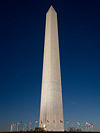
 KSF
KSF